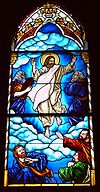- Feeding the multitude
-
"The Feeding of the 5000" redirects here. For the Crass album, see The Feeding of the 5000 (album).
 Feeding the multitudes by Bernardo Strozzi, early 17th century.
Feeding the multitudes by Bernardo Strozzi, early 17th century.
Feeding the multitude is the combined term used to refer to two separate miracles of Jesus in the Gospels.
The First Miracle, "The Feeding of the 5,000" is the only miracle (apart from the resurrection) which is present in all four canonical Gospels (Matthew 14:13-21, Mark 6:31-44, Luke 9:10-17 and John 6:5-15.[1] This miracle is also known as the miracle of the five loaves and two fish.
The second miracle, "The Feeding of the 4,000" is reported by Mark 8:1-9 and Matthew 15:32-39 but not by Luke or John. This miracle is also known as the miracle of the seven loaves and fish.
Contents
The Feeding of the 5,000
This is also known as the "miracle of the five loaves and two fish" given that the Gospel of John reports that five small barley loaves and two small fish supplied by a boy were used by Jesus to feed a multitude.[2]
According to the Gospels, when Jesus heard that John the Baptist had been killed, he withdrew by boat privately to a solitary place near Bethsaida.[3]
The crowds followed Jesus on foot from the towns. When Jesus landed and saw a large crowd, he had compassion on them and healed their sick. As evening approached, the disciples came to him and said, "This is a remote place, and it's already getting late. Send the crowds away, so they can go to the villages and buy themselves some food."
- Jesus replied, "They do not need to go away. You give them something to eat."
- "We have here only five loaves of bread and two fish," they answered.
- "Bring them here to me," he said.
Jesus directed the people to sit down on the grass. Taking the five loaves and the two fish and looking up to heaven, he gave thanks and broke the loaves. Then he gave them to the disciples, and the disciples gave them to the people. They all ate and were satisfied, and the disciples picked up twelve basketfuls of broken pieces that were left over. The number of those who ate was about five thousand men, besides women and children.
The Feeding of the 4,000
This appears in the Gospels of Mark and Matthew, is also known as the "miracle of the seven loaves and fishes" given that the Gospel of Matthew refers to seven loaves and a few small fish used by Jesus to feed a multitude.[4]
 The Church of the Multiplication in Tabgha is the site where some Christians believe the miracle to have taken place.
The Church of the Multiplication in Tabgha is the site where some Christians believe the miracle to have taken place.
According to the Gospels, a large crowd had gathered and was following Jesus. Jesus called his disciples to him and said:
- "I have compassion for these people; they have already been with me three days and have nothing to eat. I do not want to send them away hungry, or they may collapse on the way."
His disciples answered:
- "Where could we get enough bread in this remote place to feed such a crowd?"
- "How many loaves do you have?" Jesus asked.
- "Seven," they replied, "and a few small fish."
"Jesus told the crowd to sit down on the ground. Then he took the seven loaves and the fish, and when he had given thanks, he broke them and gave them to the disciples, and they in turn to the people. They all ate and were satisfied. Afterward the disciples picked up seven basketfuls of broken pieces that were left over. The number of those who ate was four thousand, besides women and children. After Jesus had sent the crowd away, he got into the boat and went to the vicinity of Magadan."
See also
References
- HarperCollins Bible Commentary, 2000
- Brown, Raymond E. An Introduction to the New Testament Doubleday 1997 ISBN 0-385-24767-2
- Kilgallen, John J. A Brief Commentary on the Gospel of Mark Paulist Press 1989 ISBN 0-8091-3059-9
Notes
- ^ Robert Maguire 1863 The miracles of Christ published by Weeks and Co. London page 185
- ^ John Clowes, 1817, The Miracles of Jesus Christ published by J. Gleave, Manchester, UK, page 109
- ^ Matthew 14:13-21, Mark 6:34-44, Luke 9:10-17, John 6:1-13)
- ^ John Clowes, 1817, The Miracles of Jesus Christ published by J. Gleave, Manchester, UK, page 161
Miracles of Jesus Cures Bleeding woman · Blind man of Bethsaida · Blind at birth · Blind near Jericho · Blind men in Galilee · Centurion's servant · Jesus cleansing a leper · Cleansing ten lepers · Deaf mute of Decapolis · Dropsy · Gennesaret healings · Hunched woman · Mother of Peter's wife · Paralytic at Bethesda · Paralytic at Capernaum · Royal official's son · Servant's ear · Withered hand

Exorcisms Raising the dead Young man from Nain · Daughter of Jairus · Raising of Lazarus
Control of nature Catch of fish · Coin in the fish's mouth · Feeding the multitude · Fig tree cursed · Marriage at Cana · Storm calmed · Transfiguration · Walking on water
Feeding the multitudePreceded by
To bring a Sword
Ministry of JesusNew Testament
EventsSucceeded by
Walking on Water
Miracles of JesusCategories:- Biblical phrases
- Miracles attributed to Jesus
Wikimedia Foundation. 2010.

